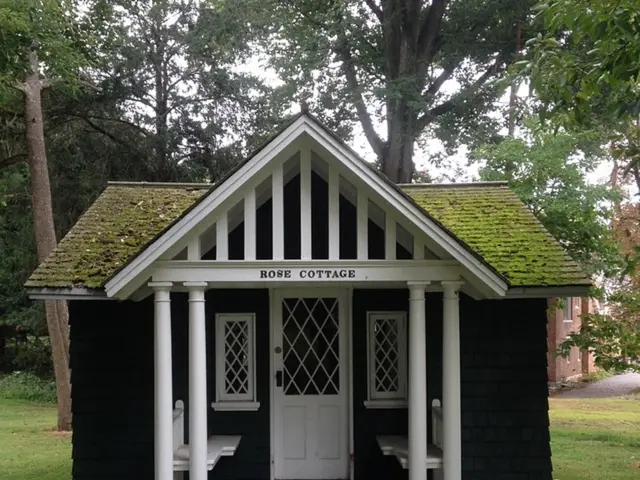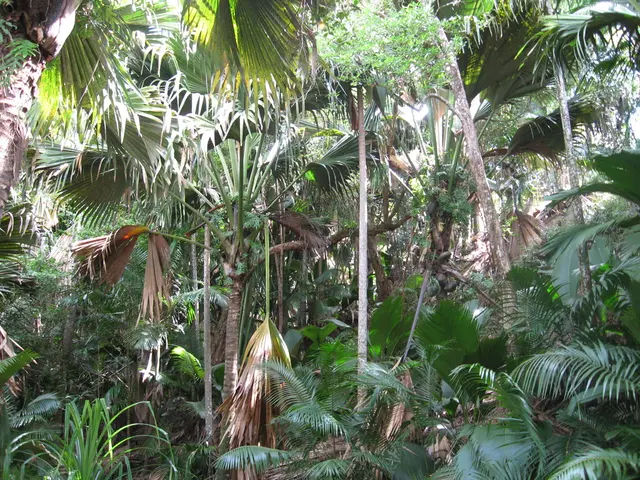Reducing Urban Heat Island Impacts through Permaculture Techniques
In a bid to reduce the urban heat island (UHI) effect and create more sustainable, livable cities, urban planners are turning to permaculture principles and smart technologies.
Designing compact, mixed-use urban areas reduces the need for extensive road networks, which contribute to UHI. However, incorporating greenery is key in fighting climate change. Urban greening serves as carbon sinks, scales up greatly reducing a city's carbon footprint, and provides shade, releases moisture through evapotranspiration, and lowers surface and air temperatures.
Effective strategies for combating the UHI effect focus on increasing vegetation, enhancing ecological connectivity, and employing sustainable water management. Key permaculture approaches include planting diverse, multilayered vegetation like trees, shrubs, and groundcovers to provide shade, cool air through evapotranspiration, and reduce heat absorption by surfaces.
Creating green roofs, green walls, and urban eco-corridors that link farms, forests, and waterways further reduce heat while supporting biodiversity and ecological resilience. Incorporating permeable and reflective surfaces in urban design helps manage water runoff and decreases heat retention.
Trees and multilayered plantings provide shade, lowering surface and air temperatures, and improve water use efficiency by reducing irrigation needs in shaded parcels. Green roofs and walls increase urban green spaces and insulating layers on buildings, reducing heat gain and contributing to cooler microclimates.
Designing continuous networks that reconnect urban green spaces with farms, wetlands, and rivers helps maintain natural water cycles and biodiversity while mitigating UHI effects by providing cooling through vegetation and water features. Using permeable pavements allows water infiltration, enabling natural cooling through evaporation and reducing surface heat retention.
Smart technologies will be key in making resource use more efficient and planning smarter in the future. Data analytics and artificial intelligence are being used in urban planning to help cities make better decisions. Educational programs teach about green spaces, saving water, and smart city planning, empowering people to help solve heat problems.
Sustainable development policies should aim to reduce hard surfaces and support walkable communities. Vertical forests in tall buildings can cool down crowded areas. Vertical farming and urban agriculture are becoming important, using hydroponic and aeroponic systems to grow food in small spaces. Drought-resistant landscaping can cut outdoor water use by 75%.
Greywater systems can save 25-30% of water used for things other than drinking. Havana, Cuba, grows over 90% of its fruits and veggies inside the city, showing how urban farming can make cities self-sufficient and food-secure. New building materials that reflect heat and capture carbon are being developed.
The cost to green 26,000 km2 of urban areas in Europe is about 60 Euro per person yearly. The monetized benefits of urban greening have a net present value (NPV) of more than 364 billion Euro. Green spaces in cities, like parks and urban forests, can lower summer temperatures by 2.5-6 °C, reducing cooling needs.
Project EverGreen's GreenCare for Communities initiative has restored nearly 200 million square feet of healthy green spaces. Seattle's Beacon Food Forest turned a seven-acre area into a food forest, demonstrating how permaculture can bring people together and provide fresh food.
By integrating these permaculture principles—diverse plant ecosystems, water-efficient landscaping, ecological connectivity, and appropriate material choices—urban environments can significantly reduce the urban heat island effect and increase overall city resilience and livability.
- Incorporating native plants into urban areas can help in the fight against climate change.
- The community can come together through gardening projects that promote sustainable water management.
- Greywater systems can contribute to water conservation efforts, saving up to 30% of non-drinking water usage.
- Effective urban planning should aim to reduce the number of hard surfaces in favor of greenery and walkable communities.
- Vertical forests in tall buildings can offer cooling effects in crowded areas, acting as natural air conditioners.
- Urban agriculture methods, such as hydroponics and aeroponics, can maximize food production in limited spaces.
- Drought-resistant landscape designs can significantly reduce outdoor water consumption by up to 75%.
- The restoration of healthy green spaces is essential, as demonstrated by Project EverGreen's GreenCare for Communities initiative.
- Beacon Food Forest in Seattle serves as an example of permaculture's potential in bringing together communities and providing fresh food.
- Urban green spaces, like parks and urban forests, can help lower summer temperatures by up to 6 °C, reducing cooling needs.
- Smart technologies can play a crucial role in making city planning more efficient and sustainable.
- Data analytics and artificial intelligence can aid urban planners in making informed decisions for their cities.
- Educational programs can help empower individuals to contribute to solving heat-related problems and promoting greener living.
- Sustainable development policies should aim to improve overall city resilience and livability.
- Permaculture principles, such as creating diverse plant ecosystems, can significantly reduce the Urban Heat Island (UHI) effect.
- Ecological connectivity, such as urban eco-corridors, can support biodiversity and promote healthier ecosystems.
- Harnessing the power of biodiversity can lead to increased resilience, as diverse plant species help maintain ecosystem services.
- Smart technologies can help improve water-efficient landscaping, leading to lower irrigation needs and a more sustainable water supply.
- Incorporating permeable and reflective surfaces in urban design can contribute to better water management and reduced heat retention.
- Green roofs and walls offer additional green spaces and insulating layers on buildings, contributing to cooler microclimates.
- Linking urban green spaces with farms, wetlands, and rivers can help maintain natural water cycles and provide cooling effects.
- The use of permeable pavements can encourage natural cooling through evaporation and reduce surface heat retention.
- Urban greening can help counteract climate change by serving as carbon sinks, reducing a city's carbon footprint, and providing shade.
- New building materials that reflect heat and capture carbon can help cities become more environmentally friendly.
- Havana, Cuba, demonstrates the potential for urban farming to make cities self-sufficient and food-secure.
- Implementing sustainable development policies can have substantial monetized benefits, with a net present value (NPV) of over 364 billion Euro in Europe alone.
- The cost to green urban areas annually is roughly 60 Euro per person, making it an affordable and valuable investment for cities.
- Green spaces in cities can contribute to improved mental and physical health, promoting overall wellness.
- In designing sustainable, livable cities, it's essential to prioritize measures addressing climatic conditions and health-related concerns.
- Encouraging workplaces to prioritize wellness programs and address medical conditions like chronic diseases, cancer, respiratory conditions, digestive health, eye health, hearing, skin health, and neurological disorders will create healthier, more resilient communities.
- Addressing various aspects of health, including fitness and exercise, sexual health, autoimmune disorders, cardiovascular health, aging, women's health, parenting, weight management, and men's health, will contribute to creating holistic, sustainable communities that prioritize overall wellness and vitality.





